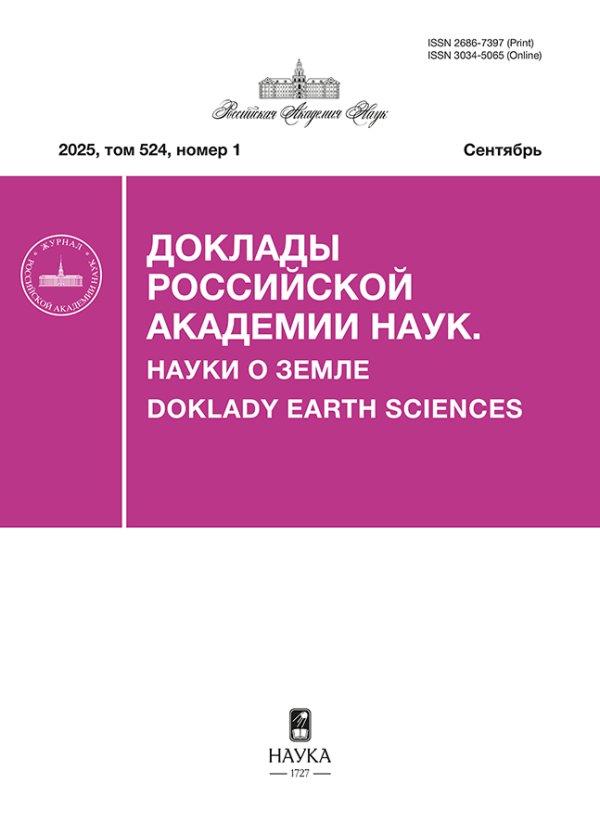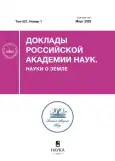Том 521, № 1 (2025)
- Год: 2025
- Выпуск опубликован: 15.03.2025
- Статей: 20
- URL: https://bakhtiniada.ru/2686-7397/issue/view/20227
ГЕОЛОГИЯ
Позднеедиакарские ледниковые отложения байконурской свиты Срединного Тянь-Шаня (восточный Кыргызстан): обоснование возраста по результатам U‒Th‒Pb (LA-ICP-MS)-геохронологических исследований обломочного циркона
Аннотация
 5-13
5-13


Время одноактного метаморфизма осадочных пород Енисейского комплекса (Ангаро-Канский блок) на основании U–Pb-датирования монацита
Аннотация
 14-24
14-24


Феномен обратной зональности в пикритовых габбро-долеритах талнахской интрузии
Аннотация
 25-32
25-32


U‒PB-ВОЗРАСТ ЗЁРЕН ДЕТРИТОВОГО ЦИРКОНА ИЗ СРЕДНЕЮРСКИХ ПЕСЧАНИКОВ СЕВЕРО-ВОСТОЧНОГО ФЛАНГА НАГОНДЖИНСКОГО ТЕРРЕЙНА (КРЯЖ УЛАХАН-СИС, РЕСПУБЛИКА САХА)
Аннотация
 33-39
33-39


Средне-позднеордовикский возраст гранитоидов, вмещающих кварцево-жильные медные месторождения шатыркольского типа (хребет Кендыктас, Южный Казахстан)
Аннотация
 40-51
40-51


СРАВНЕНИЕ ГЕОХИМИЧЕСКИХ ХАРАКТЕРИСТИК КРЕМНЕЙ И ИЗВЕСТНЯКОВ МЫСА УЭРИНГ ОСТРОВА ВРАНГЕЛЯ (НИЖНЕКАМЕННОУГОЛЬНЫЙ КОМПЛЕКС, СЕВЕРО-ВОСТОК РОССИИ)
Аннотация
 52-61
52-61


ГЕОЛОГИЯ РУДНЫХ МЕСТОРОЖДЕНИЙ
Первые SM‒ND и U‒Pb (ID-TIMS) данные о возрасте формирования и метаморфизма PT‒PD-месторождения Северный Каменник (Федорово-Панский слоистый комплекс, Кольский полуостров)
Аннотация
Впервые для Pt‒Pd-месторождения Северный Каменник (Федорово-Панский расслоенный комплекс, Кольский полуостров) проведено комплексное Sm‒Nd- и U‒Pb-изотопно-геохроноло-гическое исследование габброноритов, с которыми связана промышленная платинометалльная минерализация. Для безрудных габброноритов, подстилающих основное рудное тело и Нижний расслоенный горизонт (НРГ), получен Sm‒Nd-возраст 2498±46 млн лет с εNd(T) = –1.4. Возраст рудоносных габброноритов с промышленными содержаниями ЭПГ и Au составил 2484±26 млн лет с εNd(T) = –1.0. Полученные возрасты геохронологически идентичны и совпадают с возрастом циркона из габброноритов, для которых был определён U‒Pb-возраст 2497±4 млн лет. Изотопные Sm‒Nd-данные по минералам метаморфического генезиса (апатит, цоизит) определяютвозраст метаморфических преобразований пород комплекса на рубеже 1.96‒1.95 млрд лет, который соответствует свекофеннским метаморфическим событиям, широко проявленным на территории Фенноскандии, и в пределах других промышленных ЭПГ‒Cu‒Ni-комплексов.
 62-69
62-69


ГЕОХИМИЯ
Влияние составов Ca,Mg-карбонатных расплавов на растворимость в них серы при PТ-параметрах литосферной мантии
Аннотация
Проведены экспериментальные исследования, направленные на оценку растворимости серы в Mg,Ca-карбонатных расплавах (системы MgCO3–S, CaMg(CO3)2–S, CaCO3–S и (Mg,Сa)CO3–S, Ca# (CaO/(CaO+MgO) (мольн.)) = 0, 0.2, 0.5, 0.8 и 1.0; давление 6.3 ГПа, 1450‒1550°С, 20 ч), в условиях литосферной мантии. Экспериментально продемонстрировано, что расплавы щёлочноземельных карбонатов способны растворять от 1.9 до 6.5 мас. % S, при этом впервые установлено, что растворимость серы прямо зависит и от температуры, и от величины отношения СаO/MgO в расплаве. В частности, установлено, что растворимость серы в расплаве Ca-карбоната в 6‒7 раз выше, чем в расплаве Mg-карбоната. Полученные результаты доказывают, что обогащённые серой расплавы щёлочноземельных карбонатов могут рассматриваться как потенциальные метасоматические агенты, и не только способны осуществлять транспорт серы и углерода, но и являются потенциальными средами для кристаллизации графита и роста алмаза.
 70-77
70-77


Аномальные концентрации молибдена в современных отложениях фонового озера в арктике (Мурманская область)
Аннотация
 78-86
78-86


Растворимость NaF кр в воде при температурах 5–443°С и термодинамические свойства F – и NaF aq
Аннотация
Впервые экспериментально определена растворимость NaFкр (виллиомит) в воде в широком интервале температуры Т = 5‒443°С и давления Р = 1‒1000 бар. При высоких ТР-параметрах растворимость оказалась в 1.5‒4 раза ниже значений, предсказанных на основе термодинамической базы данных SUPCRT97. В рамках модели HKF рассчитаны термодинамические свойства NaFaq и существенно уточнены HKF-параметры базисного иона F–, необходимые для описания его свойств в области повышенных (>100°C) температур. Полученные экспериментальные данные позволяют оценить максимально возможный уровень концентрации фтора в гидротермальных щелочных флюидах, который определяется растворимостью NaFкр.
 87-92
87-92


ПАЛЕОНТОЛОГИЯ
Первое многобугорчатое млекопитающее (Multituberculata) из верхнемеловой Нэмэгэтинской свиты местонахождения Гурилин-Цав в Монголии
Аннотация
 93-97
93-97


СЕЙСМОЛОГИЯ
Два типа сейсмической активности перед извержением вулкана августина 2006-го года на Аляске
Аннотация
 98-106
98-106


ОКЕАНОЛОГИЯ
Особенности трансформации гидроакустических волн в сеисмоакустические волны в условиях глубокого моря и моря промежуточной глубины
Аннотация
 107-109
107-109


О влиянии пространственной неоднородности температуры поверхности океана в области апвеллинга на касательное напряжение трения ветра
Аннотация
 110-115
110-115


ФИЗИКА АТМОСФЕРЫ И ГИДРОСФЕРЫ
Селективное поглощение в видимой области спектра пыльной мглы на Ближнем востоке весной 2022 г.
Аннотация
 116-122
116-122


ЭКСТРЕМАЛЬНАЯ МАГНИТНАЯ БУРЯ 10–19 МАЯ 2024 Г.: ВЗАИМОДЕЙСТВИЕ НЕЙТРАЛЬНОЙ И ЗАРЯЖЕННОЙ КОМПОНЕНТ ВЕРХНЕЙ АТМОСФЕРЫ И ВОЗДЕЙСТВИЕ НА РАДИОТЕХНИЧЕСКИЕ СИСТЕМЫ
Аннотация
 123-135
123-135


КЛИМАТИЧЕСКИЕ ПРОЦЕССЫ
Летние атмосферные блокирования в северном полушарии: изменения в последние десятилетия (1993–2023)
Аннотация
 136-141
136-141


ПОЧВОВЕДЕНИЕ
Влияние почвенных гелей на устойчивость почв
Аннотация
 142-147
142-147


ГЕОЭКОЛОГИЯ
Фталаты в снежном покрове бассейна реки Селенги: содержание, источники и пространственное распределение
Аннотация
 148-154
148-154


Миграция радионуклидов из горизонтальных скважин, загруженных остеклованными высокорадиоактивными отходами
Аннотация
Высокорадиактивные отходы ядерной энергетики предлагается захоранивать в глубоких шахтных или скважинных хранилищах. Выполнен прогноз миграции актинидов (241Am, 244Cm) и продуктов деления (137Cs, 90Sr) из скважинного хранилища остеклованных ВАО. Рассчитаны максимальные концентрации радионуклидов в водах в зависимости от числа скважин, глубины и расстояния между ними, проницаемости пород, времени хранения отходов. Преимущество горизонтальных скважин над вертикальными состоит в более слабой конвекции подземных вод. При равной мощности слоя пород, отделяющих отходы от земной поверхности, температура в ближнем поле горизонтальной скважины будет ниже, чем для вертикальной скважины, поэтому интенсивность выщелачивания радионуклидов из матрицы остеклованных высокорадио-активных отходов окажется меньше.
 155-162
155-162












